You are using an out of date browser. It may not display this or other websites correctly.
You should upgrade or use an alternative browser.
You should upgrade or use an alternative browser.
India-US Relations
- Thread starter Butter Chicken
- Start date
There seems to be lot fake claims being presented for above video. Those rickshaw vehicles are vetted and driving inside the American embassy for Mr. Blinken, not on the Delhi roads.
Somehow this has become a rites of passage issue for all westerners visiting India. No visit to India used to be deemed complete without a visit to the Taj Mahal . I think the same can be said about a ride in a rickshaw or a tuk tuk as they put it.
One of the western ambassadors even travels to work each day in a rickshaw he / she owns & drives. I forgot the details though. Another one owns the Hindustan Motors Oxford Morris derivative the Ambassador car in India & drives around in it . I forget if it was the German or the UK ambassador to India .
And yes it was previous German ambassador, a great friend of India who actually drives ambasador car all around.
Secretary Raimondo to Travel to New Delhi to Deepen U.S.-India Commercial Ties, Participate in U.S.-India Commercial Dialogue and CEO Forum
Today, U.S. Secretary of Commerce Gina Raimondo will travel to New Delhi, India to meet with Indian public and private sector leaders and participate in the U.S.-India Commercial Dialogue and CEO Forum. The Secretary will convey the importance that the Biden Administration places on U.S.-India relations and emphasize the significant opportunity to deepen commercial ties between the two countries.This trip comes on the heels of last month’s successful special negotiating round for the Indo-Pacific Economic Framework in New Delhi, which was attended by senior U.S. Department of Commerce officials.
During the visit, the U.S.-India Commercial Dialogue and CEO Forum will be held on March 10th, 2023, to discuss cooperation in various sectors that could unlock new trade and investment opportunities between the two countries.
The U.S.-India CEO Forum was soft-launched by Secretary Raimondo and Indian Commerce & Industry Minister Piyush Goyal in November 2022 during a meeting between the two leaders. During the meeting, they identified key priorities as increasing supply chain resilience; enhancing energy security & reducing overall greenhouse gas emissions; advancing inclusive digital trade; and facilitating post-pandemic economic recovery, especially for small businesses.
“This is an optimistic time for U.S.-India relations, and I am excited to visit India during such a special time of year, the celebration of Holi,” said U.S. Secretary of Commerce Gina Raimondo. “Through the CEO Forum, the Commercial Dialogue, and IPEF, we are making excellent progress in bringing our countries closer together by creating new markets for trade, expanding those that already exist, and reinforcing our shared commitment to democracy.”
Secretary Raimondo will return to Washington, D.C. on Saturday, March 11th, 2023.
Secretary Raimondo to Travel to New Delhi to Deepen U.S.-India Commercial Ties, Participate in U.S.-India Commercial Dialogue and CEO Forum
Today, U.S. Secretary of Commerce Gina Raimondo will travel to New Delhi, India to meet with Indian public and private sector leaders and participate in the U.S.-India Commercial Dialogue and CEO Forum.
S Secretary for Commerce Gina Raimondo and Indian Commerce Minister Piyush Goyal will sign a Memorandum of Understanding (MoU) for closer strategic cooperation on semiconductors. MoU will pave the way for greater collaboration and coordination between the US Chips Act and India's SEMICON program.

 www.cnbctv18.com
www.cnbctv18.com

US and India to sign an MoU on semiconductors, what will it entail?
Speaking during a press conference, US Secretary for Commerce Gina Raimondo said that the MoU will pave the way for greater collaboration and coordination between the US Chips Act and India's SEMICON program.
In other news, the US ambassador designate to India seems determined to make up for his absence & the absence in India of a US ambassador since 2 yrs by providing a lot of entertainment in the remaining 2 yrs of his term.
And knowing the Modi government's great command in the art in pre empting such situations, they'd be in fire fighting mode for the next 2 yrs.
US keen to partner more with India on defence, wants specific pact for air force, says top Pentagon official
New Delhi: Noting that the trust factor between the US and India has increased, a visiting top Pentagon official Tuesday said both countries are keen on signing an agreement specific to the air forces as they look at defence technology cooperation including that for jet engines.However, Frank Kendall, US Secretary for Air Force, flagged American concerns over the Make in India programme of the Indian government saying that the requirement of having a larger share of products manufactured in India should be implemented in stages rather than expectation of having it all in one go.
“The requirements of a certain percentage to be produced in India can be problematic. They can be difficult to meet as a practical matter. We need to phase in that transition. You may start with a small fraction but have a clear path to get there over a period of time,” he said.
Responding to a question by ThePrint at a select briefing after his meetings with various stakeholders in India’s defence and security establishment, he said the US is keen to talk to India on how it can meet the country’s requirement for new fighters.
“India has its own requirements. They should decide what kind of capabilities it needs in its fighter force. If American capabilities can meet those requirements, I think we are prepared to discuss.”
“There are opportunities that exist that require modification of our existing fighters that might be suitable for India. We are very keen to work with India on that possibility,” he said alluding to the offer by American firm Lockheed Martin for its F-21 fighters, which are an upgrade of the F-16s.
Talking about greater cooperation, he said the US and India are looking at signing the air information sharing agreement.
“This is very general for us to be able to exchange what we are doing,” one of the American officials at the briefing chipped in.
Kendall said India and the US are also working on signing certain clauses of the Basic Exchange and Cooperation Agreement (BECA), one of the three foundation agreements that was signed in 2020.
Speaking about cooperation, he said that the US and India discussing the possibility of a jet engine technology transfer is a big step in the right direction and there are a lot of opportunities for both countries to collaborate on when it comes to artificial intelligence and space, besides emerging technology.
He underlined that the US is “leaning forward more than they have in the past” in terms of technology sharing.
“There is more potential there. We are also looking forward to trying and relaxing some of our constraints,” he said.
However, he flagged the American concern over when it comes to Make in India programme.
Kendall held meetings with External Affairs Minister S Jaishankar and also the team of National Security Advisor Ajit Doval.
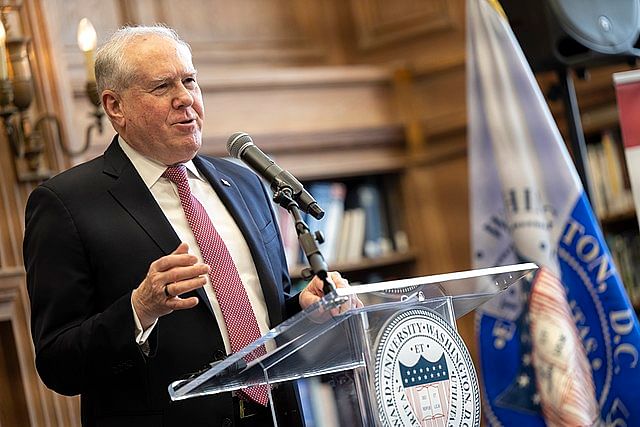
US keen to partner more with India on defence, wants specific pact for air force, says top Pentagon official
Visiting US Secretary of the Air Force Frank Kendall also flags American concerns about Make in India programme & the challenges it poses to US companies.
 theprint.in
theprint.in
What Limits Any U.S. Alliance With India Over China
Though sharing concerns about Beijing’s growing aggression, New Delhi has always been wary of aligning too closely with Washington.By Michael Schuman
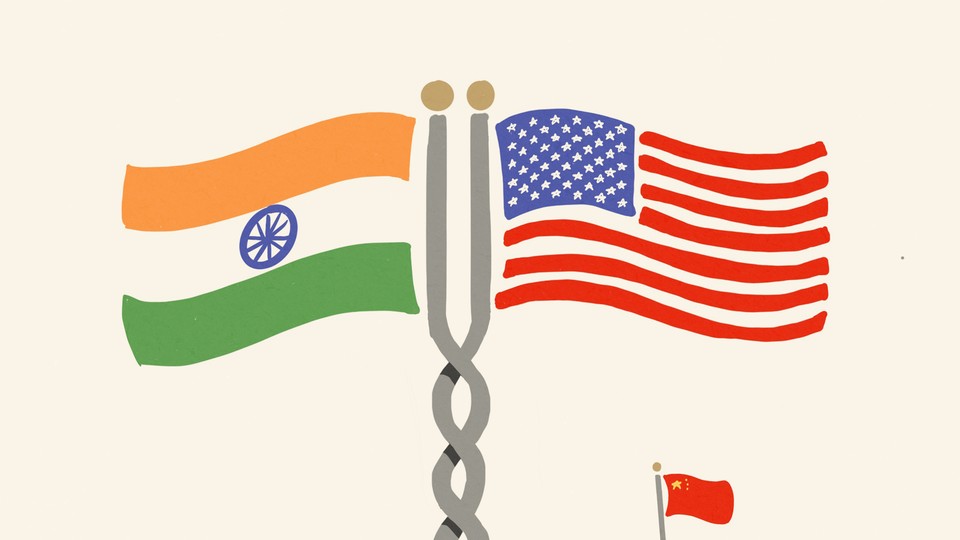
Tyler Comrie / The Atlantic
March 1, 2023
Saved Stories
The front lines of the widening confrontation between the United States and China stretch from the halls of the United Nations to the island nations of the South Pacific. Yet, as in any great geopolitical game, certain countries carry more significance than others for American interests—foremost among them India.
As Asia’s other emerging power, India could act as a crucial counterweight to Chinese influence, both in the region and outside it. That’s why Washington has been courting New Delhi with gusto. President Joe Biden has grand plans to cement the U.S. position in the Indo-Pacific, which encompasses South Asia, East Asia, and the western Pacific, through a range of diplomatic, economic, and security initiatives. India could play a determining part in their success or failure.
Whether India can be counted on to support the U.S. is an open question. Historically, relations between the two countries have been marred by deep distrust and sharp differences.
That legacy weighs on the relationship to this day, but more important is the mercurial nature of Indian foreign policy, which has been a hallmark of the nation’s sense of its place in the world since its formation in 1947. One moment, India’s leaders appear aligned with Washington; the next, they march off in their own direction, sometimes to parley with America’s enemies.
William J. Burns: The U.S.-India Relationship is bigger than Trump and Modi
Motivated by a mix of ideological conviction and cold calculation, Indian Prime Minister Narendra Modi has maintained his country’s fiercely independent approach to international affairs. That makes India the world’s ultimate swing state, the Pennsylvania or Georgia of the global geopolitical map. Which way India leans, when and why, could help decide whether the U.S. or China dominates Asia, and who prevails in great-power competitions around the world. And much like the most purple of American states, the twists of New Delhi’s choices could be a source of high-anxiety uncertainty.
Relations between the U.S. and India have veered between amity and hostility from the beginning. In October 1949, President Harry Truman dispatched his personal plane, the Independence, to transport Indian Prime Minister Jawaharlal Nehru, who was then in London, and welcomed him when he landed in Washington. The red-carpet treatment was a sign of how badly the Truman administration wished to woo the Indian leader on his first official visit to the U.S. As a committed democrat and a heroic figure in the developing world, Nehru was a valuable guest—exactly the friend Washington needed in its expanding contest with the Soviet Union.
Nehru seemed to reciprocate. In an address to Congress, he noted that, with their common political values, “friendship and cooperation between our two countries are ... natural.” Yet differences quickly got in the way. When Secretary of State Dean Acheson hosted Nehru at his home, he invited him, in the words of the readout, “to feel the greatest freedom to tell me about any situation in which he felt that action of the Department had been mistaken or unhelpful.” Nehru proceeded to lecture him until one in the morning. When Acheson expressed concern about a Communist takeover in Vietnam, Nehru said, as the secretary recorded, that the American position “was a misapplication to the East or European experience.” The two also disagreed on recognizing the new Communist regime in China, founded a few days earlier. Later, Acheson described Nehru as “one of the most difficult men with whom I have ever had to deal.”
What set the two at odds was a fundamental divergence in worldview. With the onset of the Cold War, the Americans expected Nehru to take their side. Nehru believed that dividing the world into contending blocs was inherently dangerous. In a speech given at Columbia during the same visit, he described one of India’s main foreign-policy objectives as “the pursuit of peace, not through alignment with any major power or group of powers, but through an independent approach to each controversial or disputed issue.” He continued, “The very process of a marshaling of the world into two hostile camps precipitates the conflict which it [has] sought to avoid.”
Nehru’s thinking, explained Shashi Tharoor, a member of India’s Parliament and a former minister of state for external affairs, was rooted in India’s colonial experience under the British Raj. “We had 200 years of another country deciding to speak for us on the world stage,” he told me. “The one reason Nehru was completely unwilling to join in an alliance during the Cold War was precisely because he didn’t want to mortgage India’s independence of action and opinion to any other country.”
The U.S.-India divide deepened as the Cold War progressed. Washington’s “with us or against us” attitude made India appear decidedly unreliable, and contributed to American policy makers choosing India’s mortal enemy, Pakistan, as an anti-Soviet partner.
Nehru had no wish to play second fiddle to Washington, either. His dearly held principles made him one of the most prominent figures of the Non-Aligned Movement, which was founded in 1961. He had a vision of India’s future as an influential power in its own right, and as a champion of the many new countries also emerging from colonial empires. In that respect, the U.S. was as much a potential competitor as a partner.
“There was no ideological divide between India and the United States,” Francine Frankel, an expert on Indian politics at the University of Pennsylvania, wrote in her recent book, When Nehru Looked East. “The problem was that Nehru’s conviction in India’s destiny as a great power found no place in the worldview of American policymakers.”
More than 70 years later, Nehru’s ghost haunts U.S.-India relations. The world is again splitting into two opposed camps, today centered on the U.S. and China. Once again, New Delhi is being pressured to take a side. And again, the Indians are reluctant to choose—maddening U.S. policy makers as they did during the Cold War.
This time, though, New Delhi’s calculus is somewhat different. Nehru’s position was complicated by his admiration for the Soviet Union, especially its state-led economic model, elements of which he introduced at home. Modi treats China as a threat to India’s national security. That dovetails with the Biden administration’s aim of engaging more with India as part of its wider strategy of contending with China.
Read: Biden looks East
“The U.S. is shoring up partnerships to counterbalance China,” Tharoor told me. “India is very leery of officially participating in such an enterprise, but in practice has every reason to do so given that China has turned increasingly belligerent … We, too, need to really have partners with an eye on China.”
At the center of India’s security concerns are long-standing territorial disputes with China along their remote Himalayan border. These contending claims sparked a war between the two countries in 1962, and mean the areas remain volatile today. Tensions have risen over the past five years or so because Beijing has pursued its claims with greater assertiveness—as it has in other territorial disputes, such as in the South China Sea.
Two incidents stand out. In 2017, a standoff between the two countries’ armed forces occurred in the Himalayas after China was discovered extending a road in the Doklam area claimed by Beijing and the small kingdom of Bhutan, which is an ally of India’s. Then, in 2020, in the northern region of Ladakh, an Indian territory neighboring Kashmir, Chinese forces pushed into a disputed area, apparently in response to Indian road-building. That precipitated a medieval-style melee in the Galwan Valley during which soldiers bludgeoned one another with fists and clubs, reportedly leaving 20 Indian and four Chinese service personnel dead.
“Unless or until the border standoff is resolved in India’s favor, India-China relations cannot get back to normal,” Derek Grossman, a senior defense analyst at the Rand Corporation, told me.
Adding to India’s worries are China’s close ties to Pakistan. India’s nemesis next door is among the largest participants in Beijing’s international infrastructure-building bonanza, the Belt and Road Initiative. One of its premier projects, the China-Pakistan Economic Corridor, controversially passes through a section of Kashmir controlled by Islamabad.
As a consequence, Beijing’s relations with New Delhi have deteriorated—arguably, as badly as its relations with Washington have. The U.S. government has talked about banning the Chinese social-media platform TikTok; the Indians actually did it, in 2020. Fearing that the Belt and Road Initiative is a tool for expanding Chinese influence, India has also rebuffed Beijing’s efforts to lure it into the program.
The more threatening Beijing has become, the warmer India and the U.S. have grown toward each other. The most obvious indication of this is India’s participation in the Quad, a security partnership that also includes the U.S. and the staunch American allies Australia and Japan. Initially, Indian leaders were skeptical about the Quad, fearing it might be seen as an emerging Asian NATO. Now Modi is all in. Biden elevated the Quad conferences to the top leadership level, which means that Modi routinely associates with counterparts who form the core of the U.S. alliance system in the region.
“The levels and habits of cooperation that have developed” in the Quad are “remarkable,” Kurt Campbell, Biden’s top Asian-foreign-policy aide, told me. “I think it will become a central feature of global stability and a critical element of the American strategy in the Indo-Pacific.”
The cooperation has run deeper still. Last year, the U.S. and India conducted joint military exercises not far from the disputed border with China, in the Indian state of Uttarakhand. India also joined Biden’s 14-member Indo-Pacific Economic Framework in May, and with U.S. officials and business executives seeking to reduce American reliance on China for the supply of key manufactured goods, the populous South Asian nation could be a crucial alternative. A significant increase in iPhone shipments from India-based factories may indicate that the mutually beneficial shift is under way.
Indian policy makers “have proven much more willing to embrace stronger forms of alignment with the U.S. without the fear that India would become some kind of American lapdog,” Jeff M. Smith, the director of the Asian-studies program at the Heritage Foundation, told me. Because of their recent experiences with Washington, these officials “began to realize that some of the fears of the worst critics were proven untrue and maybe this partnership with the U.S. was helping to advance India’s national interests, and maybe the U.S. wasn’t this domineering superpower that would force you to cede your sovereignty in order to cooperate.
“In fact,” he went on, “India has been able to preserve its strategic autonomy even as it has grown ever closer to the U.S.”
That last point will remain a challenge for Washington, however. The Indian leadership is as independent-minded and allergic to formal alliances as ever. Modi, like Nehru, won’t take a side.
New Delhi will therefore continue to forge relationships, join forums, and make choices that are unpalatable to U.S. policy makers. That becomes clear with a quick glance at the itinerary of Modi’s recent travels. In May, Modi stood with Biden at a Quad summit in Tokyo; four months later, he was in Samarkand, in Uzbekistan, with Russian President Vladimir Putin, Iranian President Ebrahim Raisi, and the Chinese leader Xi Jinping at a meeting of the Shanghai Cooperation Organization, a grouping of Central Asian states that is widely perceived as anti-Western.
“If we think because they are the world’s largest democracy and we are the world’s oldest democracy that we should get along perfectly—not going to happen. We have to be realistic,” Rand’s Grossman said. “They are never going to become an ally with us, because they hold nonalignment and strategic autonomy as core principles of their foreign and security policies.”
That means India and the U.S. will continue to have their differences. Mere months after India joined Biden’s economic framework, New Delhi withdrew from participation in the partnership’s trade component.
Most glaringly, Modi has broken with the U.S. position on Russia’s invasion of Ukraine. Although Modi did criticize Putin over the war during the September meeting in Samarkand, he has ignored pressure from Washington to take a harder line. Modi also joined Xi in abstaining from United Nations votes on resolutions condemning Moscow.
In this stance, New Delhi exhibits how it will prioritize India’s national interests regardless of whether they coincide with American wishes. Modi is unwilling to alienate Russia, which remains an important military and economic partner for India, and a supplier of copious quantities of oil—at a good discount.
Even on China, which each sees as a threat, New Delhi and Washington aren’t entirely on the same page. Although both are apprehensive about China’s closer ties with Russia, for instance, they diverge in approaches to that challenge. Policy makers in New Delhi probably regard maintaining links to Moscow as a way to influence Russia’s relationship with China and forestall any coordinated action the two might take against India.
In Acheson’s day, such transgressions might have soured the entire U.S.-India relationship. But the Biden team is being more pragmatic. Agreeing to disagree with Modi, it has pursued closer cooperation with India anyway. In the Biden administration’s view, it can’t afford to undermine the coalition it’s building in the Indo-Pacific “in order to get a symbolic victory on the Ukraine issue,” Smith, of the Heritage Foundation, told me.
This flexibility has not gone unnoticed in New Delhi. “America seems to have the patience to let the Indians find their comfort levels,” Tharoor told me, “which have certainly been progressing in the direction the U.S. would like.”
Still, Washington’s willingness to separate issues has a downside. Biden has generally chosen to overlook Modi’s illiberal domestic actions in order to pursue the overarching geopolitical goal of confronting China. This is an uncomfortable concession for a “values based” president who is engaged in what he paints as a struggle between autocracy and democracy.
India thus highlights the challenge the U.S. faces in confronting China in an integrated world, because New Delhi’s approach to international relations may be typical of the dominant direction of 21st-century global diplomacy. The “us versus them” nature of the Cold War does not apply to a complex and multipolar global order. In effect, Nehru’s belief in nonalignment is ascendant in world affairs.
For Washington, that may be a more difficult world, demanding a degree of adaptability that U.S. policy has often lacked. Washington will have to learn how to achieve its foreign-policy goals without the formal alliances that once served as the bedrock of the U.S.-led order. And in the coming confrontation with China, Washington needs all the friends it can find, however it may get them.
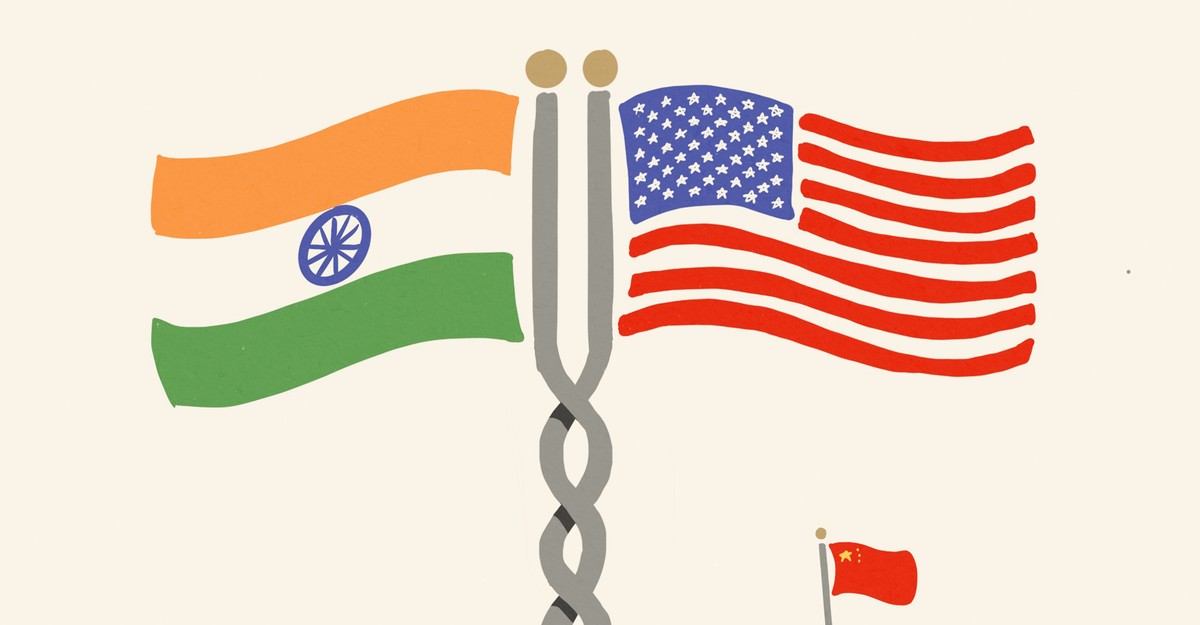
What Limits Any U.S. Alliance With India Over China
Though sharing concerns about Beijing’s growing aggression, New Delhi has always been wary of aligning too closely with Washington.
‘Broken Barriers’: US Bullish On Jet Engine Tech-Sharing With India
Frank Kendall, Secretary, US Air Force, Tuesday said Washington and New Delhi have “broken barriers” in terms of jet engine technology-sharing even as American conglomerate General Electric (GE) has offered to manufacture its military engines in India.Kendall, who held wide-ranging discussions with National Security Advisor (NSA) Ajit Doval and External Affairs Minister S Jaishankar on Tuesday, told a select a group of journalists that talks concerning technology sharing between the US and India are “moving forward”. “Our relationship with India has grown and expanded … Air and space forces have a lot of potential for cooperation that will be good for both of our economies,” Kendall, who is responsible for organising, training, and equipping the US Air and Space Forces, said.
Last month at the Aero India Show, US aircraft dominated Indian skies even as Washington showed its military might by sending F-35 and F-16 fighter planes and supersonic heavy bombers B-1B Lancers to Bengaluru. (US F-35s, Bombers At Aero India An Outcome Of iCET Talk Between Doval And Sullivan)
“We did break some barriers, we did make some progress… US is leaning forward more than it did before as far as technology sharing is concerned,” he said, adding that during his conversations with Doval and Jaishankar it was evident that both sides are keen on this and that the US is ready to support India’s ‘Make in India’ drive in the defence sector.
He said both sides are relaxing some of the provisions that government technology sharing. He added some of the clauses under ‘Make In India’ can be “problematic” so those discussions are going on to “make it easier for us to move forward”.
“There’s a shared perception that we can do more. There is a desire to move forward,” Kendall said when asked about GE’s proposal to make jet engines in this country.
According to him, the fact that GE is keen on producing and sharing jet engine technology in India is a “breakthrough” of sorts in US-India defence ties and said he hopes that both sides will “find a way to move that forward”.
‘China Is Our Basic Challenge’
The development comes after India and the US set in motion a new Initiative on Critical and Emerging Technology (iCET). The first round of talks took place between NSA Doval and his American counterpart Jake Sullivan in January in Washington.Under the iCET, both sides have decided to develop a new bilateral Defense Industrial Cooperation Roadmap to accelerate technological cooperation between both countries for the joint development and production, with an initial focus on exploring projects related to jet engines, munition-related technologies, and other systems.
“We need to work with our partners to ensure that we stay ahead of the game,” Kendall said.
He also said it is up to India to decide what kind of capabilities it wants for its Air Force.
The US is keen on selling Lockheed Martin’s F-21 fighters, Boeing’s F/A-18 Super Hornet and MQ-9 Reaper armed drones made by General Atomics, among others to India, which is also America’s ‘Major Defence Partner’.
Kendall also said that India and the US are at an early stage to conclude an ‘Air Information Sharing Agreement’ that will be “over and above” the defence foundational pacts that India and the US have signed - Basic Exchange and Cooperation Agreement (BECA), Logistics Exchange Memorandum of Agreement (LEMOA), and Communications Compatibility and Security Agreement (COMCASA).
On the US-India collaboration in the Indo-Pacific region, he said: “China is our basic challenge… Because of some of its strategic objectives we are concerned about China.”
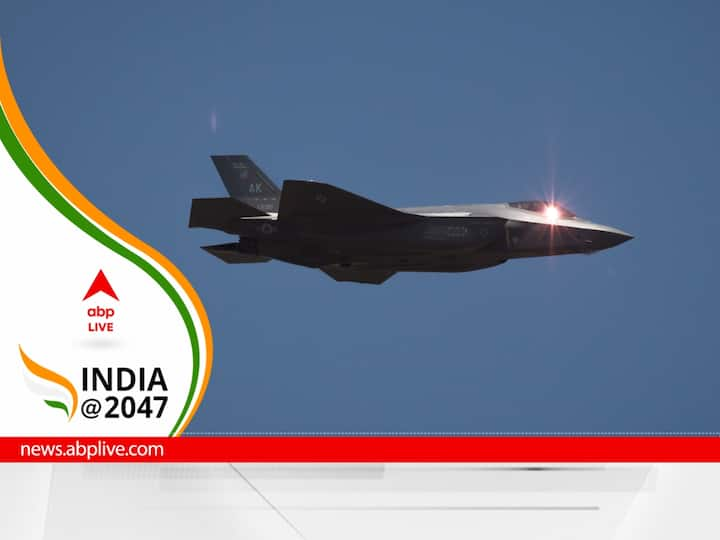
‘Broken Barriers’: US Bullish On Jet Engine Tech-Sharing With India
Frank Kendall, Secretary, US Air Force, Tuesday said the US is “leaning forward” on India more than it used to in the past on transfer of military technology.
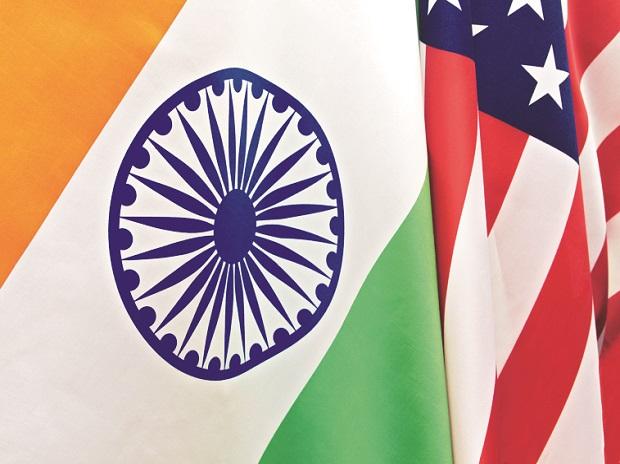
US, Indian navies hold sixth meeting on aircraft carrier technology
However, the Indian Navy is keen to work with the US Navy and to pick up its operational practices and expertise in carrier-borne operations
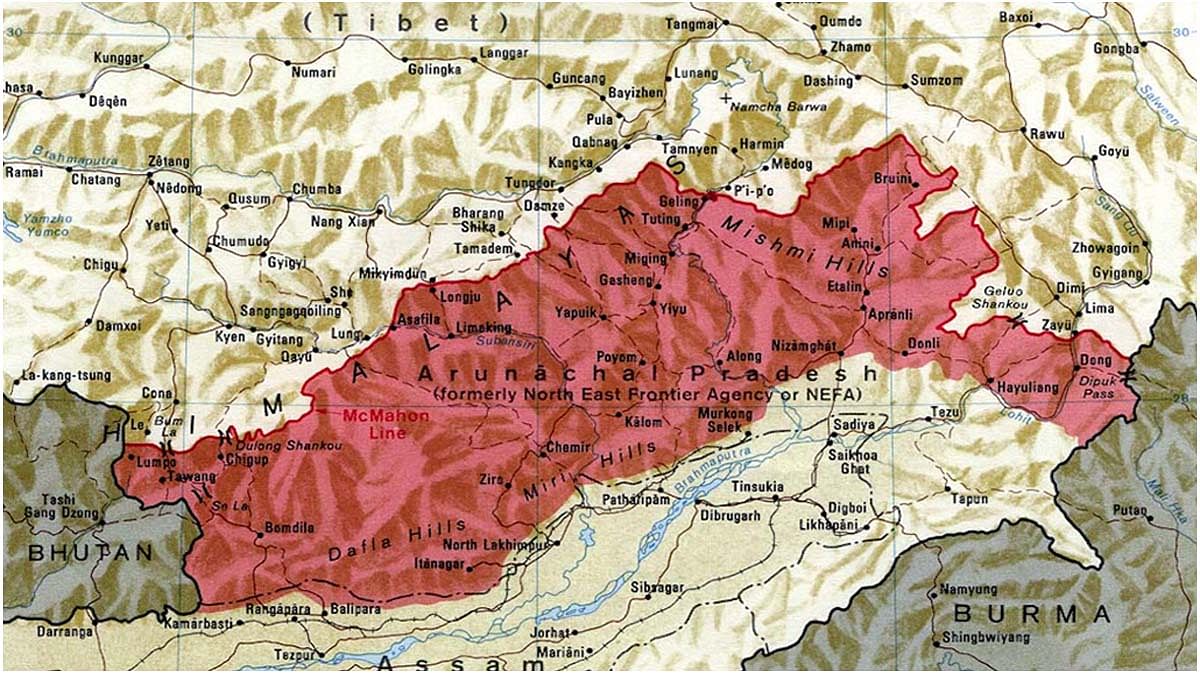
US Senate recognises McMahon Line as international boundary, calls Arunachal an 'integral part' of India
A bipartisan resolution, which was first introduced in the US Senate last month, also supports India’s 'sovereignty and territorial integrity'.
 theprint.in
theprint.in
It was Mexican ambassador who moved around in an auto.
Somehow this has become a rites of passage issue for all westerners visiting India. No visit to India used to be deemed complete without a visit to the Taj Mahal . I think the same can be said about a ride in a rickshaw or a tuk tuk as they put it.
One of the western ambassadors even travels to work each day in a rickshaw he / she owns & drives. I forgot the details though. Another one owns the Hindustan Motors Oxford Morris derivative the Ambassador car in India & drives around in it . I forget if it was the German or the UK ambassador to India .
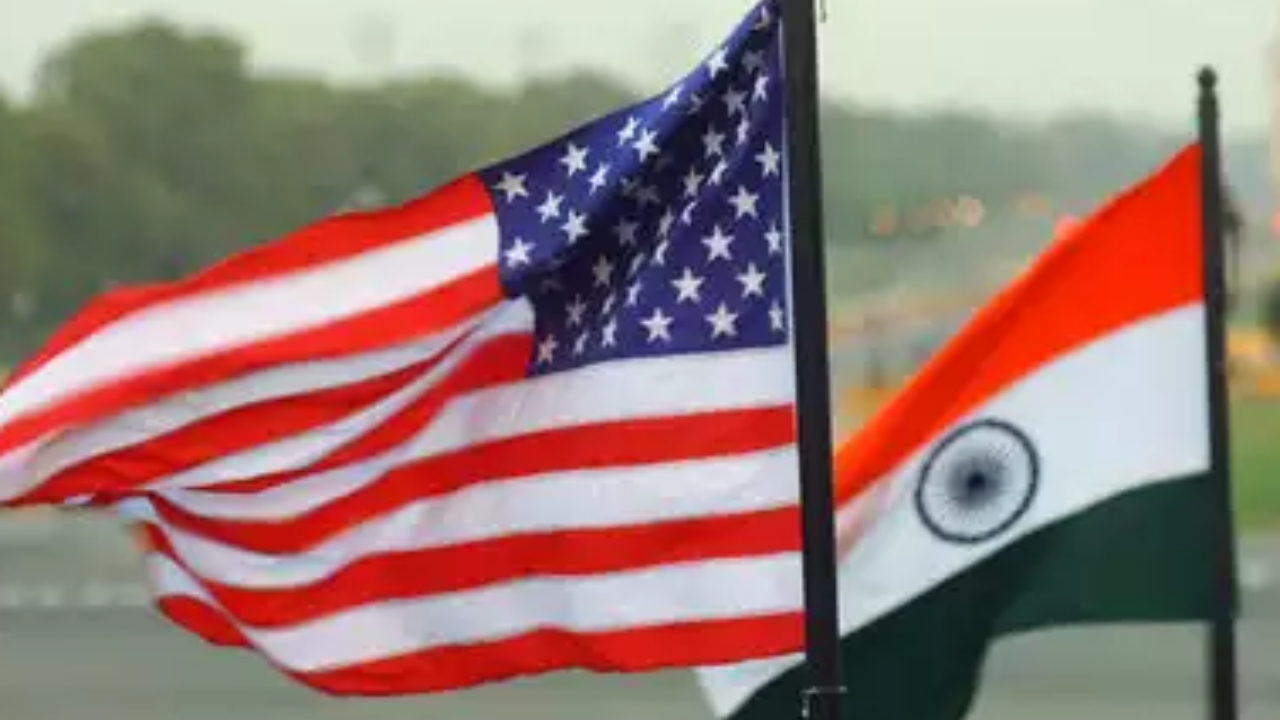
'US wants to ensure concrete outcomes in areas that India wants to deliver' - Times of India
Times of India brings the Latest & Top Breaking News on Politics and Current Affairs in India & around the World, Cricket, Sports, Business, Bollywood News and Entertainment, Science, Technology, Health & Fitness news & opinions from leading columnists.

